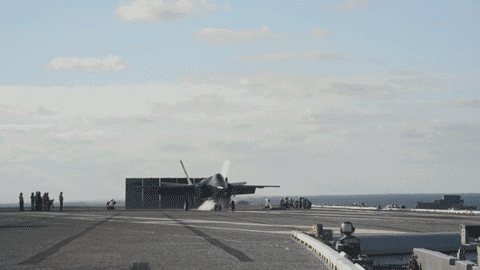Training to Fly the Most Advanced Fighter Jet
In the TV show Undercover Boss, executives work on the front lines of their companies to get a better sense of what employees and customers think of the business. In Kory DeFore’s case, he swapped roles from teacher to student when he entered the rigorous F-35 Lightning II training program that he helped build.
DeFore’s job as a contract instructor pilot is teaching U.S. and international service personnel to fly the F-35. Now a student in the course he teaches, DeFore took to the skies in an F-35 for the first time in March when he flew as a Navy Reservist for Strike Fighter Squadron 101 at Eglin Air Force Base in Florida.
The experience, he says, gave him a new outlook as an instructor.
No Plan B
DeFore always wanted to be a pilot and didn’t have a backup plan for his career. He caught the flying bug at an early age listening to an uncle’s stories from his service flying A-6s. After college, DeFore piloted F-18s for a decade as a naval aviator flying on and off aircraft carriers for combat missions around the world.
Following his separation from active duty, DeFore took on his current role as a Navy Reservist and a Lockheed Martin instructor pilot. When he arrived at the Eglin Air Force Base Integrated Training Center in 2012, he was one of a handful of F-35 instructors and the Navy squadron had yet to start flying the aircraft.
Fast forward four years and now more than 250 pilots and 2,500 maintainers from six nations have graduated from the F-35 Training System coached by DeFore and his colleagues, and the number of students in training is at an all-time high.

Wearing Two Hats
As he advances through the training program, DeFore says he is tracking ideas to make the syllabus and instruction more effective.
“I’m taking notes on opportunities I see to tighten up the training,” says DeFore. “We receive feedback that the training program does a good job of preparing pilots to fly the airplane, and we want to continue to improve the experience.”
To prepare for his first flight, DeFore points to the simulator missions as an important component. His instructors substituted the usual emergency Full Mission Simulator flights with new scenarios to throw situations at him that he wouldn’t expect and ensure he was ready.
DeFore says the Navy is focused on integrating the F-35 into its fleet and building employment strategies, and the training objective is to prepare pilots to make an immediate impact.
“As training continues to ramp up, what’s exciting to me is the chance to take what the pilots are seeing on the jet back to the instructor corps,” says DeFore. “Being in the pilot’s shoes, so to speak, helps me relay the best way to simulate training missions as the Navy develops and refines tactics.”
Back Up and Flying
DeFore says that going through the training program has reminded him that it takes the efforts of many to keep jets flying.
“On a Navy aircraft carrier, you have 5,000 people below the flight deck supporting the mission. From my perspective, that united sense of purpose is everywhere you look on the F-35 program,” says DeFore.
“Being in the ready room again and going through training reinforces the appreciation I have for the maintainers working on the jets and keeping pilots safe, and all the people working hard on the program every day. It’s humbling to be a part of it.”
So, what is it like to fly the latest fighter jet after teaching how the systems work for four years?
“It was awesome to finally get in the jet!” says DeFore. “I was definitely ready and confident to hop into the F-35 for the first time. I'm excited to implement some minor changes to prepare future classes even more effectively and further improve the foundation pilots receive at the Academic Training Center.”




